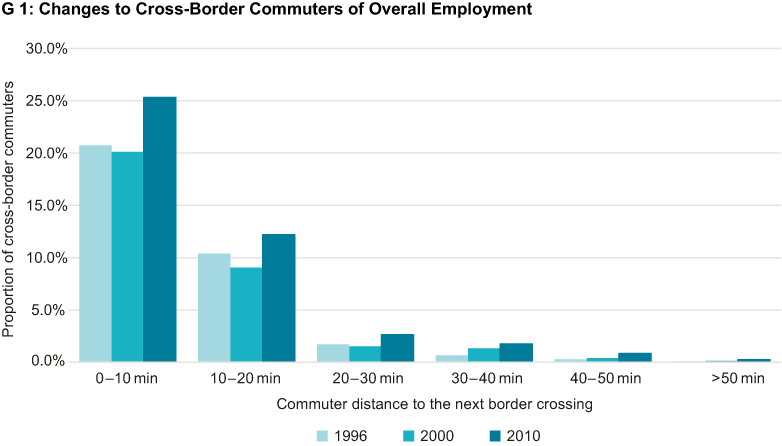Businesses – the Winners from the Free Movement of Persons
- Innovation
- Labour Market
- Research Project
- KOF Bulletin
A large number of entrepreneurs in Switzerland say that free movement of persons is a key element in the success of their business. But has free movement of persons really made businesses larger, more productive and more innovative? A new KOF study shows that it has: businesses have indeed become larger and more innovative. In fact, due to free movement of persons, they are increasingly deciding to produce in Switzerland.

A decisive question in the discussion concerning the implementation of the initiative against mass immigration (MII) has been the influence that the reintroduction of immigration restrictions would have on businesses in Switzerland. According to indications provided by Swiss businesses, these implications could be significant. Would the new barriers to immigration thus have an effect on the growth of Swiss firms? Would these barriers result in firms transferring production abroad or a fall in the number of businesses establishing themselves in Switzerland?
Answers to these questions may be found in a new KOF study. The authors Jan Ruffner and Michael Siegenthaler examined how the abolition of barriers to immigration as a result of the introduction of free movement of persons impacted upon businesses. It was possible to infer from this not only whether the businesses benefited from free movement of persons but also some indications as to the effects which the reintroduction of obstacles to immigration would have on businesses.
One benefit for the analysis was that the liberalisation of the Swiss labour market has had an unintended side-effect: businesses situated near to the border benefited over the first few years, in particular from the abolition of various labour market obstacles. This was because the Swiss labour market opened up not only for immigrants from Europe but also for cross-border commuters.
Due to the opening-up of the Swiss labour market to cross-border commuters, their numbers in Switzerland increased significantly: today there are more than 150,000 more cross-border commuters than there were at the start of 2002. This increase occurred naturally, above all in regions close to the border. For example, the proportion of cross-border commuters out of overall employees has increased by around five percentage points since 2000 in municipalities less than 10 minutes by car from a border crossing (see G 1). Today, more than one out of every four employees in these municipalities is a cross-border commuter. The graph also shows how much the increase in cross-border commuters was concentrated in areas close to the border. Businesses situated near to the border may thus wish to take advantage of the easier access to cross-border commuters.
Not only higher employment but also more innovation
What effects have the liberalisation of the labour market had on the size, productivity and innovativeness of firms near to the border? The authors approached this question by comparing growth for businesses situated near to border crossings with the growth of businesses that are further away from the border. Ruffner and Siegenthaler focused here above all on the years 2002 to 2007, as businesses close to the border were already benefiting from easier access to EU workers during this period, whilst various barriers on the employment of EU citizens continued to apply to businesses that were further away from the border. In these analyses, it is apparent that easier access to foreign workers has had a clear positive effect on the growth of businesses near to the border, which were able to increase turnover and employment over the period at a higher rate than businesses further away from the border. Free movement of persons has thus helped the businesses to grow.
How can the stronger growth in employment and turnover for businesses close to the border be explained? According to the study, three factors play a central role. First, some businesses were suffering from significant labour shortages over the years prior to the introduction of free movement of persons, which limited their growth. As a result of the opening-up of the labour market, businesses reported fewer problems in recruiting suitable staff – which in turn led to significantly higher employment growth. The authors show that businesses close to the border, which suffered from a particularly significant shortage of skilled labour during the 1990s, became much more productive after 2002 compared to businesses elsewhere in Switzerland.
According to the study, a second explanation for the higher growth rates for businesses close to the border is that such businesses became more innovative. It is apparent that businesses close to the border expanded their research departments more than other businesses. A significant proportion of the new researchers employed were cross-border commuters. Improved access to foreign researchers and the lower shortage of skilled workers have also enhanced the innovativeness measured for businesses close to the border: for instance, over the years since 2002, their number of patent applications has increased at a significantly higher rate than those of businesses further away from the border.
Third, another significant effect resulted from the fact that businesses had increasingly transferred production activities towards the border in order to benefit from better access to European workers. In other words, free movement of persons has had an impact on businesses’ decisions concerning their location. Over the years after 2002, the number of new businesses grew at a higher rate in regions near to the border than in regions further away from the border. In addition, the results also showed that businesses with branches in various parts of Switzerland before the introduction of free movement of persons increased their employment levels after 2002, in particular in the facilities situated near to the border.
All in all, the results show that businesses near to the border in Switzerland have benefited substantially from easier access to workers from the EU. Had they been unable to rely on cross-border commuters, the businesses would have grown at a slower rate and there would have been fewer businesses near to the border. However, the results also suggest that the businesses have been a joint cause of the substantial influx of foreign nationals over the years since the labour market was opened up. Free movement of persons has had the effect of creating jobs that would not even have existed without free movement of persons. The resulting increase in demand for workers helps to explain why the labour market outlook for local workers in labour markets close to the border has not deteriorated, despite high immigration. However, the results of the study also show that a reduction in immigration to Switzerland cannot be achieved without dampening down the growth in jobs and thus putting the brakes on economic development.
KOF Working Paper No. 424 “From Labour to Cash Flow? The Abolition of Immigration Restrictions and the Performance of Swiss Firms” by Jan Ruffner und Michael Siegenthaler.
Contacts
No database information available
- Location location_onLEE G 301
- Phone phone+41 44 633 93 67
- web_asset Detail page
- contactsvCard Download
KOF Konjunkturforschungsstelle
Leonhardstrasse 21
8092
Zürich
Switzerland

